Comparative Assessment of Grassland Dynamic and Its Response to Drought Based on Multi-Index in the Mongolian Plateau
Abstract
:1. Introduction
2. Results
2.1. Spatial and Temporal Distribution of Fv, Fb, and NPP
2.2. Dynamic Analysis of Grassland
2.3. Correlation Analysis of Grassland Indexes to scPDSI
2.4. Changes and Trends in Grassland Response to Drought
3. Discussion
3.1. Methodology
3.2. Climate Factors on Grassland Vegetation Dynamic
3.3. The Role of Ecological Policies in Grassland Restoration
4. Materials and Methods
4.1. Study Area
4.2. Data Source and Processing
4.3. Methods
4.3.1. Estimation of Fv
4.3.2. Estimation of Fb
4.3.3. Estimation of NPP
4.3.4. Grassland Dynamic Analysis
4.3.5. Correlation Analysis
5. Conclusions
Author Contributions
Funding
Institutional Review Board Statement
Informed Consent Statement
Data Availability Statement
Conflicts of Interest
References
- Jiang, L.P.; Qin, Z.H.; Xie, W. Estimation of Grassland Ecosystem Services Value of China Using Remote Sensing Data. J. Nat. Resour. 2007, 22, 161–170. [Google Scholar]
- Wei, Z.; Han, Y.; Liang, Z.; Yizhao, C.; Lu, H.; Weimin, J. Dynamics of grassland carbon sequestration and its coupling relation with hydrothermal factor of Inner Mongolia. Ecol. Indic. 2018, 95, 1–11. [Google Scholar]
- Yanagawa, A.; Sasaki, T.; Jamsran, U.; Okuro, T.; Takeuchi, K. Factors limiting vegetation recovery processes after cessation of cropping in a semiarid grassland in Mongolia. J. Arid. Environ. 2016, 131, 1–5. [Google Scholar] [CrossRef]
- Gang, C.; Wang, Z.; Zhou, W.; Chen, Y.; Groisman, P.Y. Assessing the Spatiotemporal Dynamic of Global Grassland Water Use Efficiency in Response to Climate Change from 2000 to 2013. J. Agron. Crop Sci. 2016, 202, 343–354. [Google Scholar] [CrossRef]
- Soussana, J.F.; Loiseau, P.; Vuichard, N.; Ceschia, E.; Balesdent, J.; Chevallier, T.; Arrouays, D. Carbon cycling and sequestration opportunities in temperate grasslands. Soil Use Manag. 2010, 20, 219–230. [Google Scholar] [CrossRef]
- Luo, Z.; Wu, W.; Yu, X.; Song, Q.; Yang, J.; Wu, J.; Zhang, H. Variation of Net Primary Production and Its Correlation with Climate Change and Anthropogenic Activities over the Tibetan Plateau. Remote Sens. 2018, 10, 1352. [Google Scholar] [CrossRef]
- Yang, H.; Mu, S.; Li, J. Effects of ecological restoration projects on land use and land cover change and its influences on territorial NPP in Xinjiang, China. Catena 2014, 115, 85–95. [Google Scholar] [CrossRef]
- Zhang, R.; Liang, T.; Guo, J.; Xie, H.; Feng, Q.; Aimaiti, Y. Grassland dynamics in response to climate change and human activities in Xinjiang from 2000 to 2014. Sci. Rep. 2018, 8, 1–11. [Google Scholar] [CrossRef]
- Ying, Q.; Hansen, M.C.; Potapov, P.V.; Tyukavina, A.; Wang, L.; Stehman, S.V.; Moore, R.; Hancher, M. Global bare ground gain from 2000 to 2012 using Landsat imagery. Remote Sens. Environ. 2017, 194, 161–176. [Google Scholar] [CrossRef] [Green Version]
- Zhang, Y.; Zhang, C.B.; Wang, Z.Q.; An, R.; Li, J.L. Comprehensive Research on Remote Sensing Monitoring of Grassland Degradation: A Case Study in the Three-River Source Region, China. Sustainability 2019, 11, 1845. [Google Scholar] [CrossRef] [Green Version]
- Nanzad, L.; Zhang, J.; Tuvdendorj, B.; Yang, S.; Rinzin, S.; Prodhan, F.A.; Sharma, T.P.P. Assessment of Drought Impact on Net Primary Productivity in the Terrestrial Ecosystems of Mongolia from 2003 to 2018. Remote Sens. 2021, 13, 2522. [Google Scholar] [CrossRef]
- Vicente-Serrano, S.M.; Gouveia, C.; Camarero, J.J.; Begueria, S.; Trigo, R.; L6Pez-Moreno, J.I.; Azorin-Molina, C.; Pasho, E.; Lorenzo-Lacruz, J.; Revuelto, J. Response of vegetation to drought time-scales across global land biomes. Proc. Natl. Acad. Sci. USA 2013, 110, 52–57. [Google Scholar] [CrossRef] [Green Version]
- Dai, A. Drought under Global Warming: A Review. Wiley Interdiscip. Rev. Clim. Chang. 2011, 2, 45–65. [Google Scholar] [CrossRef] [Green Version]
- Li, C.; Filho, W.L.; Yin, J.; Hu, R.; Wang, J.; Yang, C.; Yin, S.; Bao, Y.; Ayal, D.Y. Assessing vegetation response to multi-time-scale drought across inner Mongolia plateau. J. Clean. Prod. 2018, 179, 210–216. [Google Scholar] [CrossRef]
- Di, L.; Scanlon, B.R.; Longuevergne, L.; Sun, A.Y.; Fernando, D.N.; Save, H. GRACE satellite monitoring of large depletion in water storage in response to the 2011 drought in Texas. Geophys. Res. Lett. 2013, 40, 3395–3401. [Google Scholar]
- Kazemzadeh, M.; Malekian, A. Spatial characteristics and temporal trends of meteorological and hydrological droughts in northwestern Iran. Nat. Hazards 2016, 80, 1–20. [Google Scholar] [CrossRef]
- Vicente-Serrano, S.M.; López-Moreno, J.I.; Beguería, S.; Lorenzo-Lacruz, J.; Azorin-Molina, C.; Morán-Tejeda, E. Accurate Computation of a Streamflow Drought Index. J. Hydrol. Eng. 2012, 17, 318–332. [Google Scholar] [CrossRef] [Green Version]
- Zhang, Q.; Kong, D.; Singh, V.P.; Shi, P. Response of vegetation to different time-scales drought across China: Spatiotemporal patterns, causes and implications. Glob. Planet. Chang. 2017, 152, 1–11. [Google Scholar] [CrossRef] [Green Version]
- Li, L.Y.; Tian, M.R.; Liang, H.; Chen, Y.M.; Qian, J.P. Spatial and Temporal Changes of Vegetation Coverage and Influencing Factors in Hulun Buir Grassland During 2000–2016. J. Ecol. Rural. Environ. 2018, 34, 584–591. [Google Scholar]
- Ciais, P.; Reichstein, M.; Viovy, N.; Granier, A.; Ogee, J.; Allard, V.; Aubinet, M.; Buchmann, N.; Bernhofer, C.; Carrara, A.; et al. Europe-wide reduction in primary productivity caused by the heat and drought in 2003. Nature 2005, 437, 529–533. [Google Scholar] [CrossRef] [PubMed]
- Zhao, M.; Running, S.W. Drought-Induced Reduction in Global Terrestrial Net Primary Production from 2000 through 2009. Science 2010, 329, 940–943. [Google Scholar] [CrossRef] [Green Version]
- Bao, G.; Liu, Y.; Liu, N.; Linderholm, H.W. Drought variability in eastern Mongolian Plateau and its linkages to the large-scale climate forcing. Clim. Dyn. 2015, 44, 717–733. [Google Scholar] [CrossRef]
- Yin, G.; Zengyun, H.U.; Chen, X.; Tashpolat, T. Vegetation dynamics and its response to climate change in Central Asia. J. Arid. Land 2016, 8, 375–388. [Google Scholar] [CrossRef] [Green Version]
- Azimi, S.; Moghaddam, M.A. Modeling Short Term Rainfall Forecast Using Neural Networks, and Gaussian Process Classification Based on the SPI Drought Index. Water Resour. Manag. 2020, 34, 1369–1405. [Google Scholar] [CrossRef]
- Karina, W.; Ursula, G.; Volker, H. Identifying Droughts Affecting Agriculture in Africa Based on Remote Sensing Time Series between 2000–2016: Rainfall Anomalies and Vegetation Condition in the Context of ENSO. Remote Sens. 2017, 9, 831. [Google Scholar]
- Nobre, C.A.; Marengo, J.A.; Seluchi, M.E.; Cuartas, L.A.; Alves, L.M. Some Characteristics and Impacts of the Drought and Water Crisis in Southeastern Brazil during 2014 and 2015. J. Water Resour. Prot. 2016, 8, 252–262. [Google Scholar] [CrossRef] [Green Version]
- Zhang, L.; Wu, P.; Zhou, T. Aerosol forcing of extreme summer drought over North China. Environ. Res. Lett. 2017, 12, 1–7. [Google Scholar] [CrossRef]
- Mohammat, A.; Wang, X.; Xu, X.; Peng, L.; Yang, Y.; Zhang, X.; Myneni, R.B.; Piao, S. Drought and spring cooling induced recent decrease in vegetation growth in Inner Asia. Agric. For. Meteorol. 2013, 178–179, 21–30. [Google Scholar] [CrossRef]
- Yi, L.; Ren, L.; Ma, M.; Yang, X.; Fei, Y.; Jiang, S. An insight into the Palmer drought mechanism based indices: Comprehensive comparison of their strengths and limitations. Stoch. Environ. Res. Risk Assess. 2016, 30, 119–136. [Google Scholar]
- Wang, Q.; Yang, Y.; Liu, Y.Y.; Tong, L.J.; Zhang, Q.P.; Li, J.L. Assessing the Impacts of Drought on Grassland Net Primary Production at the Global Scale. Sci. Rep. 2019, 9, 1–8. [Google Scholar] [CrossRef] [Green Version]
- Huang, L.; He, B.; Chen, A.; Wang, H.; Liu, J.; Lű, A.; Chen, Z. Drought dominates the interannual variability in global terrestrial net primary production by controlling semi-arid ecosystems. Sci. Rep. 2016, 6, 1–6. [Google Scholar]
- Miao, B.; Li, Z.; Liang, C.; Wang, L.; Jia, C.; Bao, F.; Chao, J. Temporal and spatial heterogeneity of drought impact on vegetation growth on the Inner Mongolian Plateau. Rangel. J. 2018, 40, 113–128. [Google Scholar]
- Xie, B.; Qin, Z.; Yang, W.; Chang, Q. Spatial and temporal variation in terrestrial net primary productivity on Chinese Loess Plateau and its influential factors. Trans. Chin. Soc. Agric. Eng. 2014, 30, 244–253. [Google Scholar]
- Wang, Z.Q.; Chang, J.F.; Peng, S.S.; Piao, S.L.; Ciais, P.; Betts, R. Changes in productivity and carbon storage of grasslands in China under future global warming scenarios of 1.5 degrees C and 2 degrees C. J. Plant Ecol. 2019, 12, 804–814. [Google Scholar] [CrossRef]
- Dukes, J.S.; Chiariello, N.R.; Cleland, E.E.; Moore, L.A.; Shaw, M.R.; Thayer, S.; Tobeck, T.; Mooney, H.A.; Field, C.B. Responses of grassland production to single and multiple global environmental changes. PLoS Biol. 2005, 3, e319. [Google Scholar] [CrossRef] [Green Version]
- Wang, J.; Brown, D.G.; Chen, J. Drivers of the dynamics in net primary productivity across ecological zones on the Mongolian Plateau. Landsc. Ecol. 2013, 28, 725–739. [Google Scholar] [CrossRef]
- John, R.; Chen, J.; Ou-Yang, Z.-T.; Xiao, J.; Becker, R.; Samanta, A.; Ganguly, S.; Yuan, W.; Batkhishig, O. Vegetation response to extreme climate events on the Mongolian Plateau from 2000 to 2010. Environ. Res. Lett. 2013, 8, 1–14. [Google Scholar] [CrossRef]
- Wang, W.; Wang, W.J.; Jun-Sheng, L.I.; Hao, W.U.; Chao, X.U.; Liu, X.F. Remote Sensing Analysis of Impacts of Extreme Drought Weather on Ecosystems in Southwest Region of China Based on Normalized Difference Vegetation Index. Res. Environ. Sci. 2010, 23, 1447–1455. [Google Scholar]
- Xu, L.; Samanta, A.; Costa, M.H.; Ganguly, S.; Nemani, R.R.; Myneni, R.B. Widespread decline in greenness of Amazonian vegetation due to the 2010 drought. Geophys. Res. Lett. 2011, 38. [Google Scholar] [CrossRef] [Green Version]
- Matthews, H.D.; Weaver, A.J.; Meissner, K.J.; Gillett, N.P.; Eby, M. Natural and anthropogenic climate change: Incorporating historical land cover change, vegetation dynamics and the global carbon cycle. Clim. Dyn. 2004, 22, 461–479. [Google Scholar] [CrossRef]
- Shi, Y. A preliminary study of signal, impact and foreground of climatic shift from warm-dry to warm-humid in Northwest China. J. Glaciol. Geocryol. 2002, 24, 219–226. [Google Scholar]
- Mu, S.; Zhang, C.; Zhou, W.; Li, J.; Sun, Z.; Gang, C. Spatial-temporal dynamics of grassland coverage and its response to climate change in China during 1982–2010. Acta Geogr. Sin. 2014, 69, 15–30. [Google Scholar]
- Vandandorj, S.; Gantsetseg, B.; Boldgiv, B. Spatial and temporal variability in vegetation cover of Mongolia and its implications. J. Arid. Land 2015, 7, 450–461. [Google Scholar] [CrossRef]
- Zhang, B.; Zhu, J.J.; Liu, H.M.; Pan, Q.M. Effects of extreme rainfall and drought events on grassland ecosystems. Chin. J. Plant Ecol. 2014, 38, 1008–1018. [Google Scholar]
- Hua, L.; Ma, Z.; Zhong, L. A comparative analysis of primary and extreme characteristics of dry or wet status between Asia and North America. Adv. Atmos. Sci. 2011, 28, 352–362. [Google Scholar] [CrossRef]
- Yin, Y.; Liu, H.; Liu, G.; Hao, Q.; Wang, H. Vegetation responses to mid-Holocene extreme drought events and subsequent long-term drought on the southeastern Inner Mongolian Plateau, China. Agric. For. Meteorol. 2013, 178–179, 3–9. [Google Scholar] [CrossRef]
- Zhou, Y.; Ning, L.I.; Zhong-Hui, J.I.; Xiao-Tian, G.U.; Fan, B.H. Temporal and Spatial Patterns of Droughts Based on Standard Precipitation Index (SPI) in Inner Mongolia during 1981–2010. J. Nat. Resour. 2013, 28, 1694–1706. [Google Scholar]
- Jiang, Y.; Wang, R.; Peng, Q.; Wu, X.; Cheng, L. The relationship between drought activity and vegetation cover in Northwest China from 1982 to 2013. Nat. Hazards 2018, 92, 1–19. [Google Scholar] [CrossRef]
- Zhang, X.; Pan, X.; Xu, L.; Wei, P.; Yin, Z.; Shao, C. Analysis of spatio-temporal distribution of drought characteristics based on SPEI in Inner Mongolia during 1960–2015. Trans. Chin. Soc. Agric. Eng. 2017, 33, 190–199. [Google Scholar]
- Mu, S.; Yang, H.; Li, J.; Chen, Y.; Gang, C.; Zhou, W.; Ju, W. Spatio-temporal dynamics of vegetation coverage and its relationship with climate factors in Inner Mongolia, China. J. Geogr. Sci. 2013, 23, 231–246. [Google Scholar] [CrossRef]
- Zhang, Y.; Wang, Q.; Wang, Z.; Yang, Y.; Li, J. Impact of human activities and climate change on the grassland dynamics under different regime policies in the Mongolian Plateau. Sci. Total Environ. 2020, 698, 1–10. [Google Scholar] [CrossRef]
- Kemp, D.R.; Guodong, H.; Xiangyang, H.; Michalk, D.L.; Fujiang, H.; Jianping, W.; Yingjun, Z. Innovative grassland management systems for environmental and livelihood benefits. Proc. Natl. Acad. Sci. USA 2013, 110, 8369–8374. [Google Scholar] [CrossRef] [Green Version]
- Harris, I.; Jones, P.D.; Osborn, T.J.; Lister, D.H. Updated high-resolution grids of monthly climatic observations—The CRU TS3.10 Dataset. Int. J. Climatol. 2014, 34, 623–642. [Google Scholar] [CrossRef] [Green Version]
- Wang, Z.; Zhang, Y.; Yang, Y.; Zhou, W.; Gang, C.; Zhang, Y.; Li, J.; An, R.; Wang, K.; Odeh, I. Quantitative assess the driving forces on the grassland degradation in the Qinghai—Tibet Plateau, in China. Ecol. Inform. 2016, 33, 32–44. [Google Scholar] [CrossRef]
- White, M.A.; Thornton, P.E.; Running, S.W.; Nemani, R.R. Parameterization and Sensitivity Analysis of the BIOME–BGC Terrestrial Ecosystem Model: Net Primary Production Controls. Earth Interact. 2000, 4, 1–84. [Google Scholar] [CrossRef]
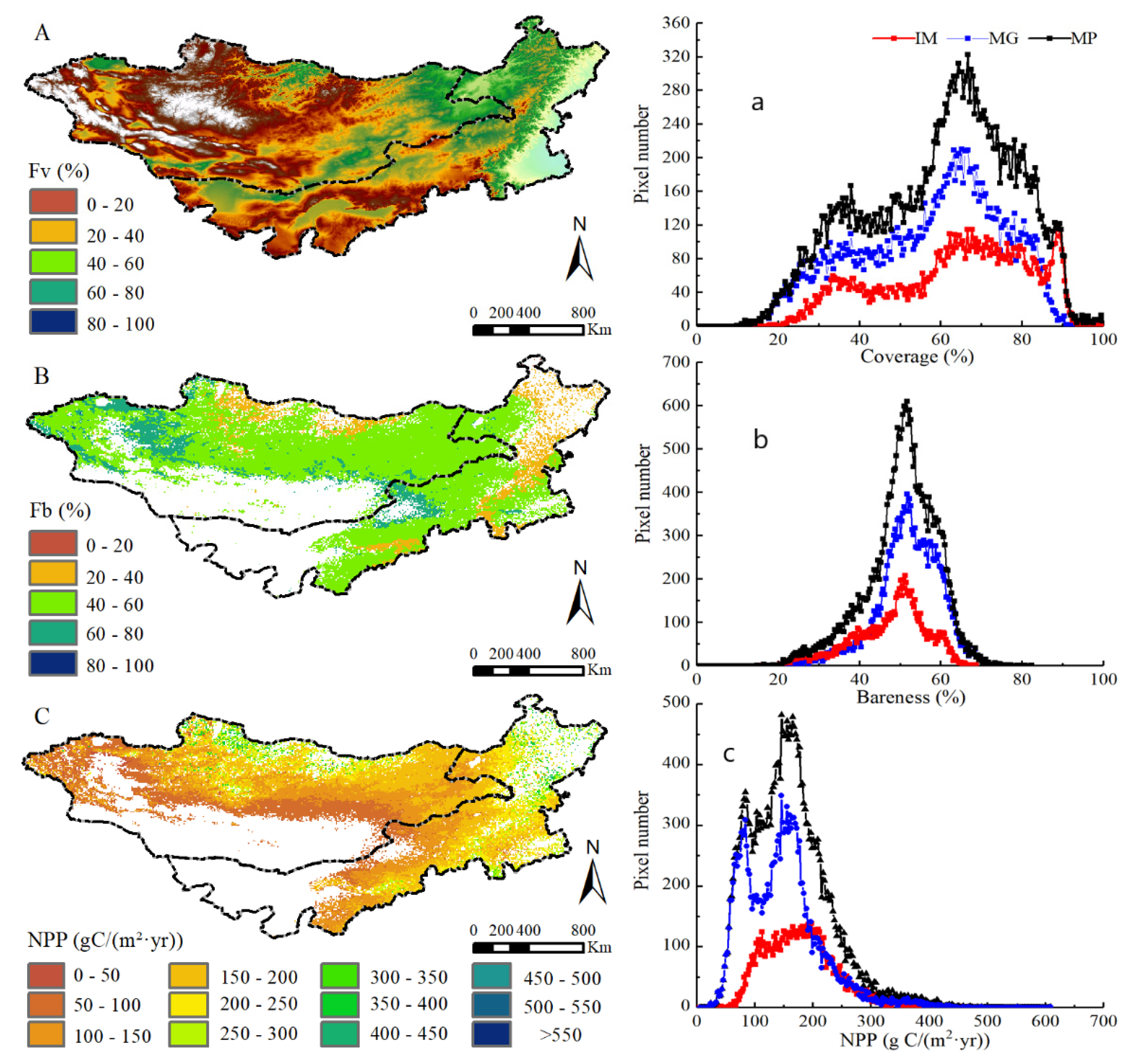

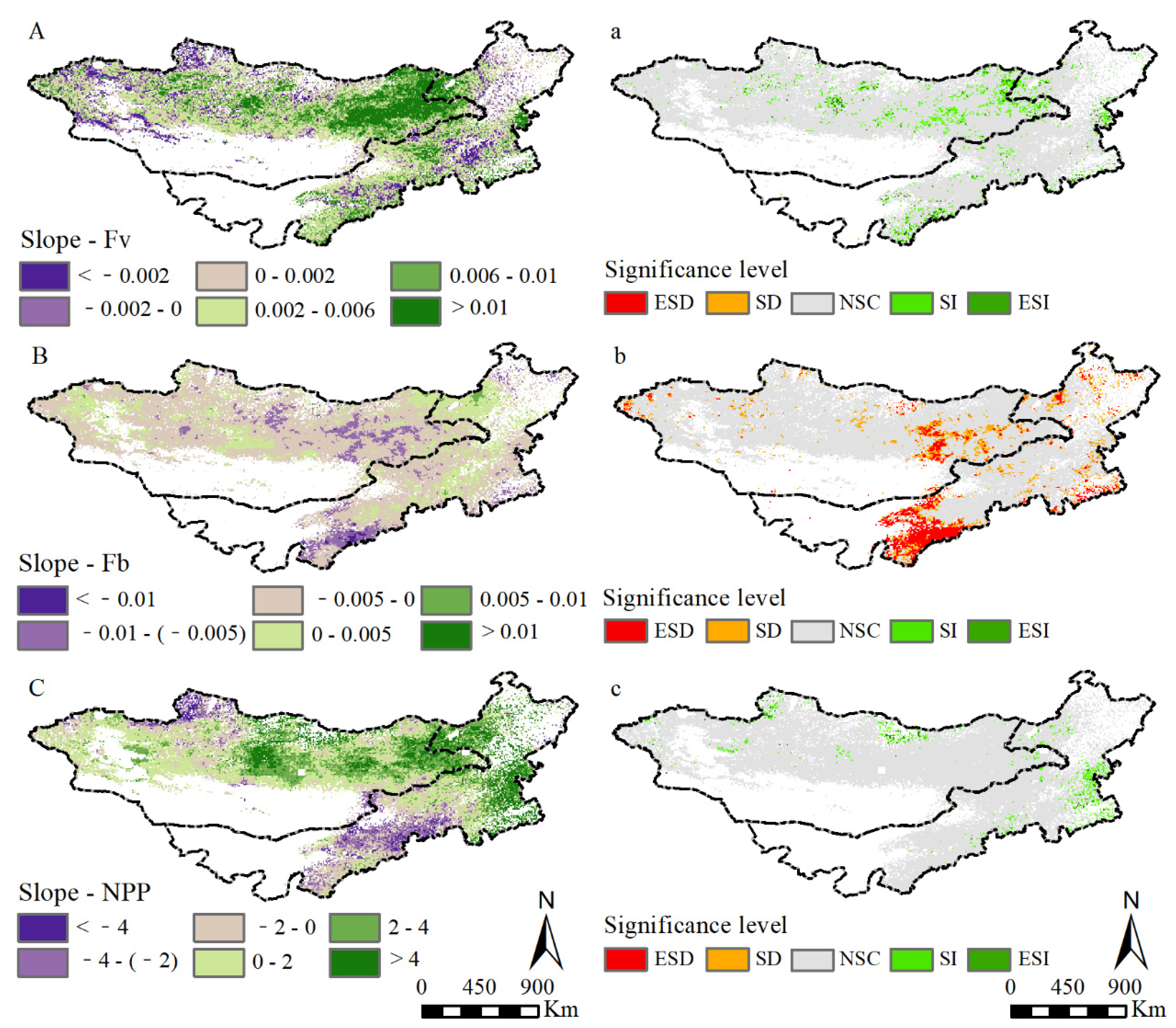
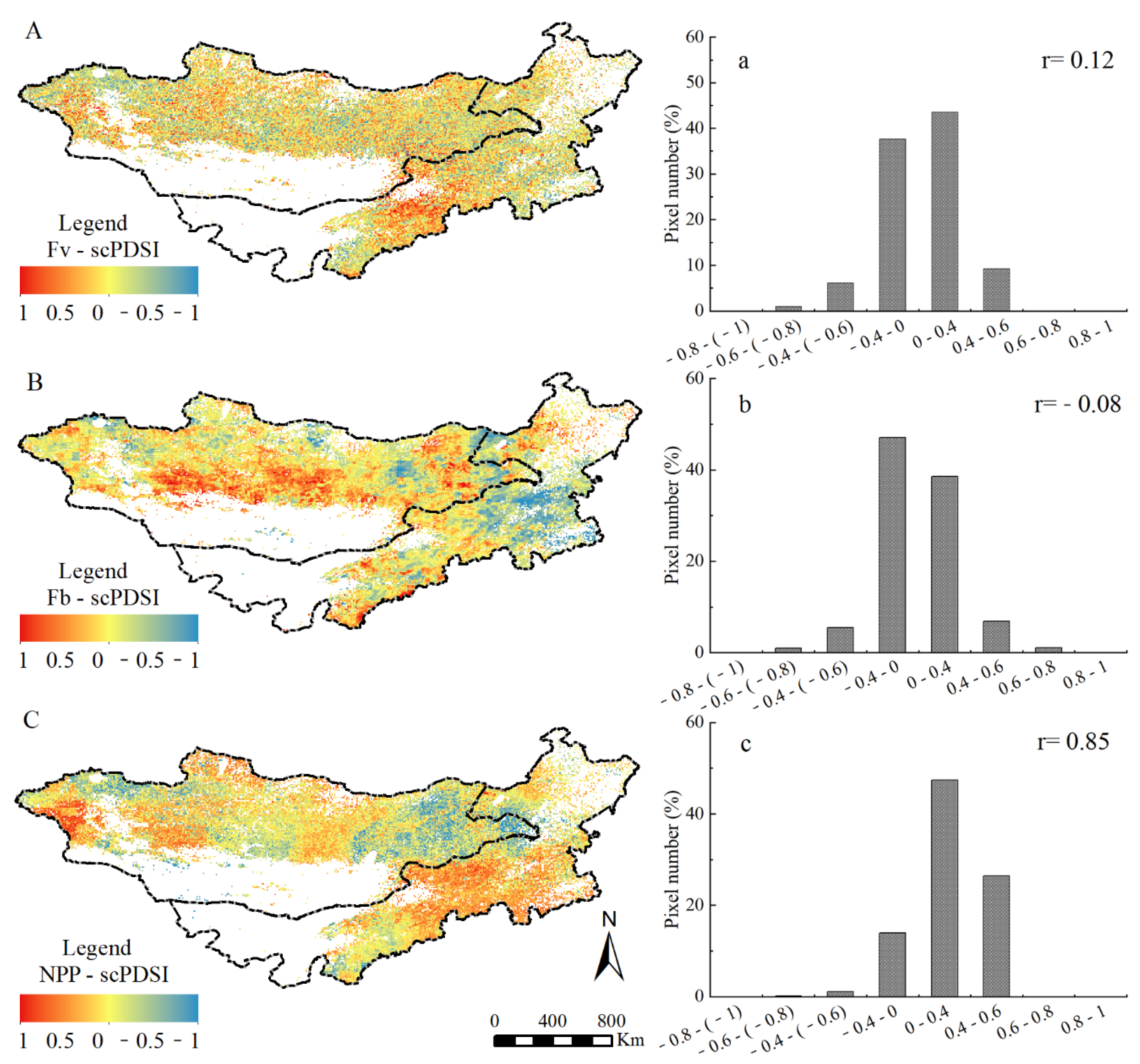
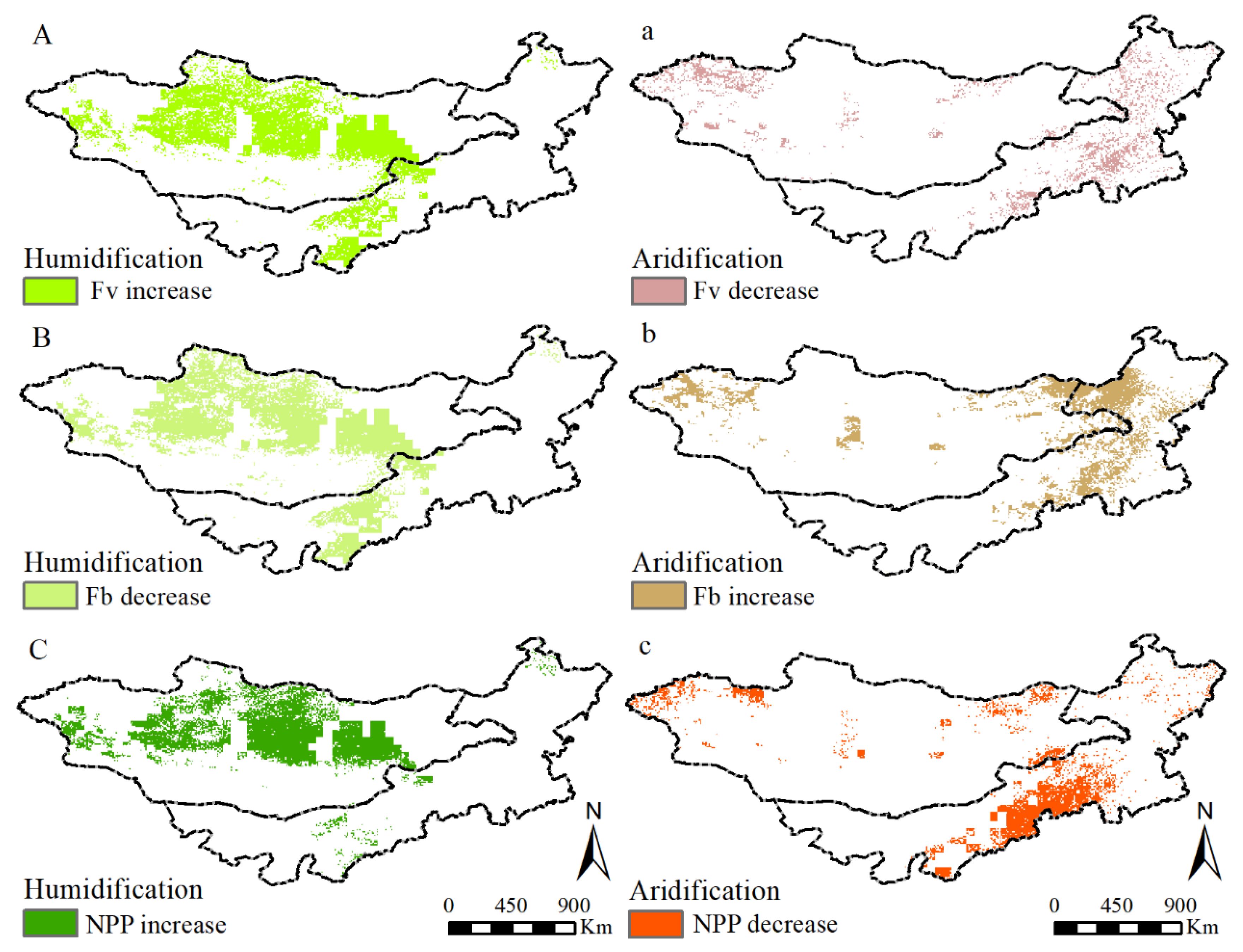
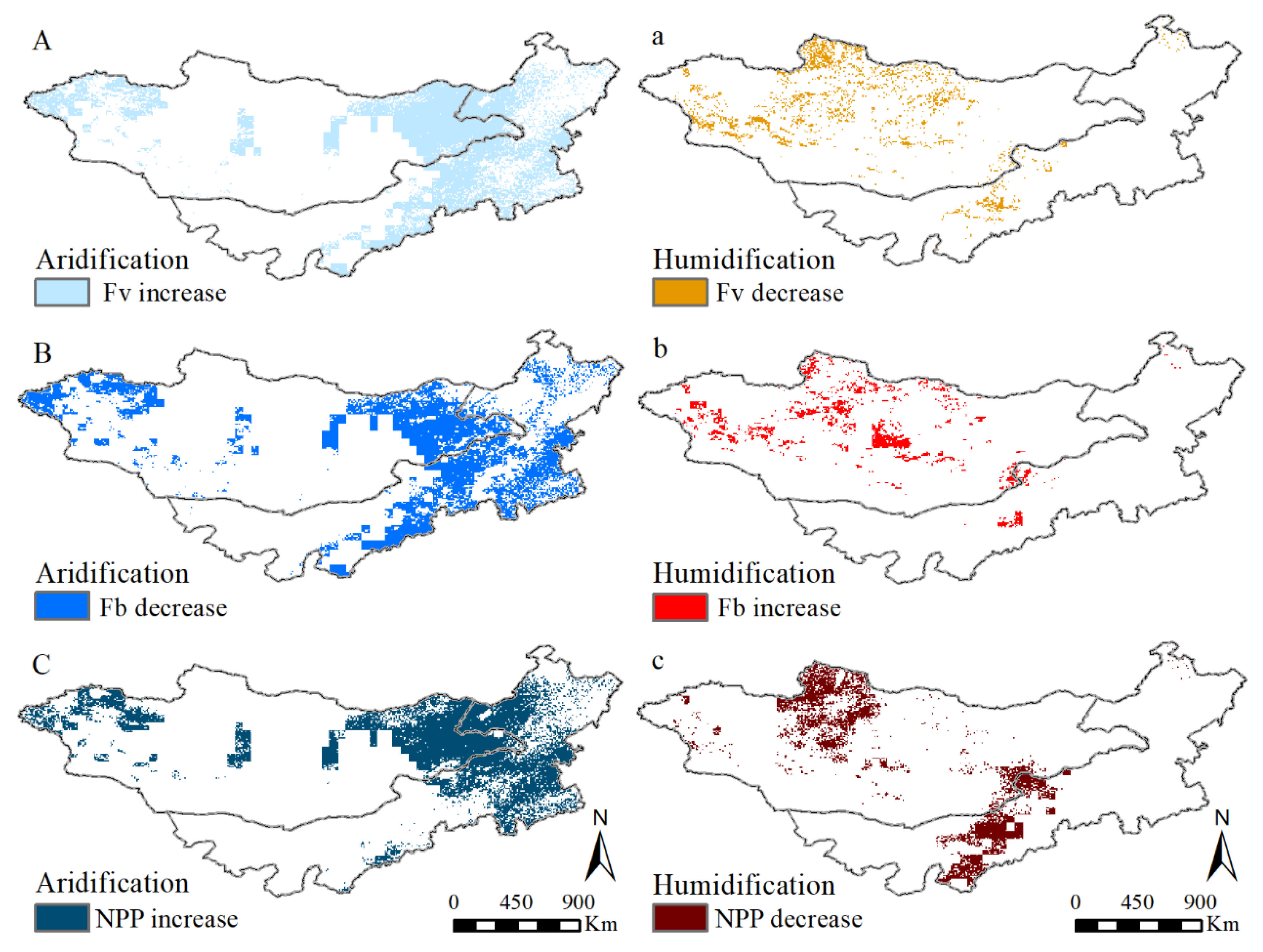

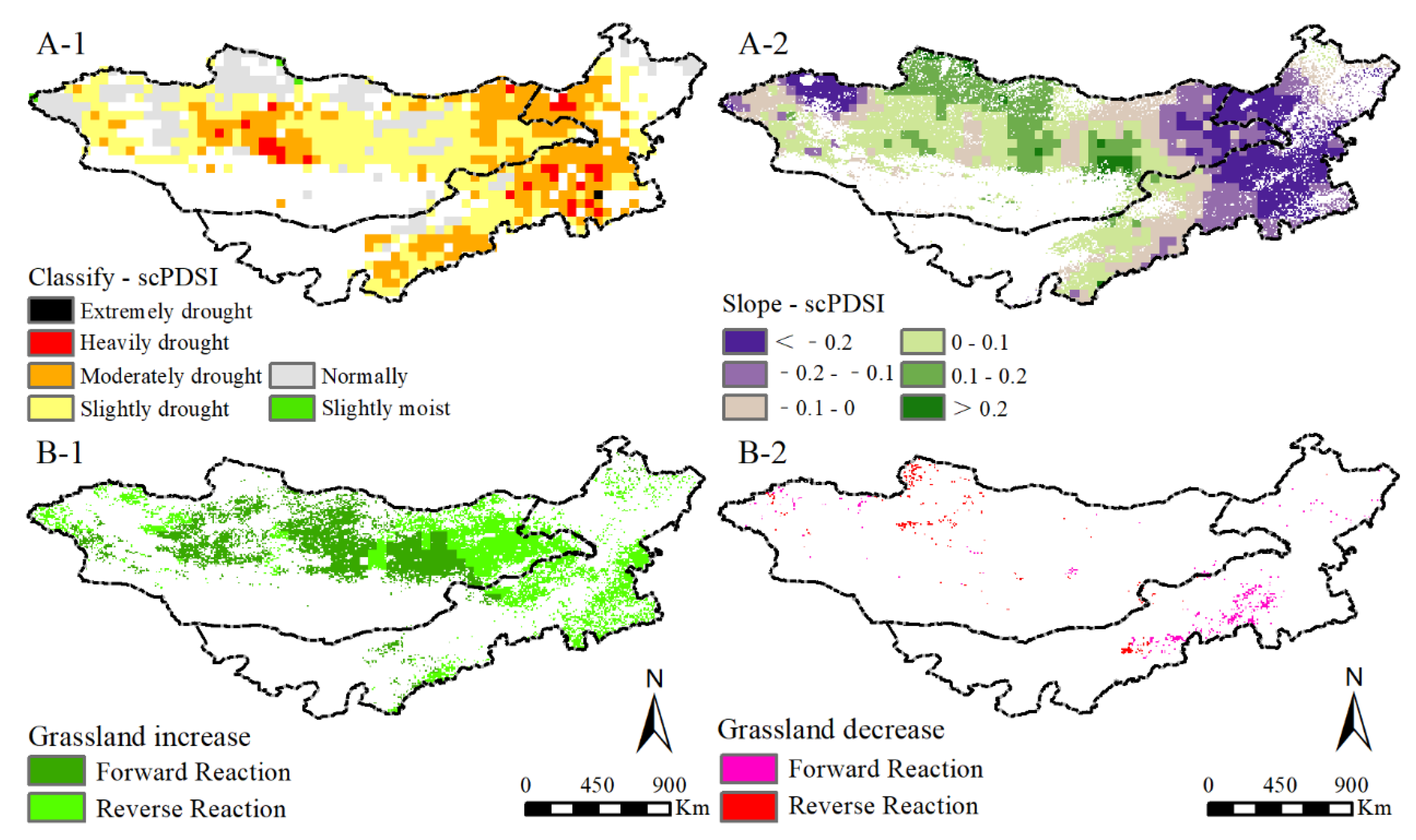
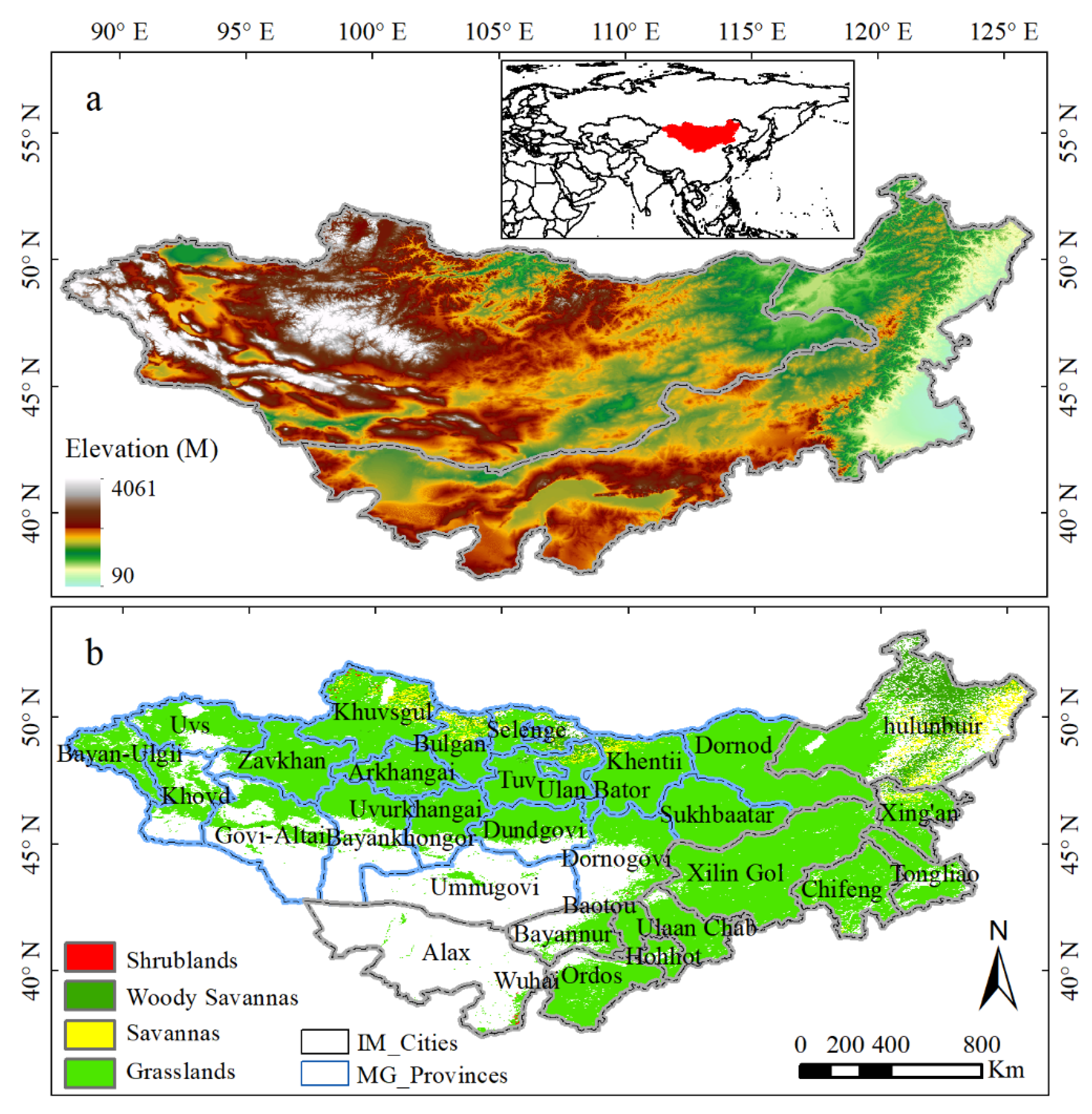
| Original Serial Number | Original Land Use Type | Serial Number after Reclassification | Land Use Type after Reclassification |
|---|---|---|---|
| 1 | Evergreen Needleleaf Forest | 1 | Forest |
| 2 | Evergreen Broadleaf Forest | ||
| 3 | Deciduous Needleleaf Forest | ||
| 4 | Deciduous Broadleaf Forest | ||
| 5 | Mixed Forest | ||
| 6 | Closed Shrublands | 2 | Shrubland |
| 7 | Open Shrublands | ||
| 8 | Woody Savannas | ||
| 9 | Savannas | ||
| 10 | Grasslands | 3 | Grassland |
| 11 | Permanent Wetlands | 4 | Wetland |
| 12 | Croplands | 5 | Farmland |
| 13 | Cropland/Natural Vegetation Mosaic | ||
| 14 | Barren or Sparsely Vegetated | 6 | Desert |
| 15 | Snow and Ice | 7 | Water |
| 16 | Water Bodies | ||
| 17 | City and Built-up | 8 | City |
| scPDSI | Classification of Dry and Wet | scPDSI | Classification of Dry and Wet |
|---|---|---|---|
| ≥4 | Extreme moist | −1~−2 | Slightly drought |
| 3~4 | Heavy moist | −2~−3 | Moderate drought |
| 2~3 | Moderate moist | −3~−4 | Heavy drought |
| 1~2 | Slightly moist | ≤−4 | Extreme drought |
| −1~1 | Normally | - | - |
| Change Direction | Grassland Conditions | scPDSI | Fv | Fb | NPP |
|---|---|---|---|---|---|
| control response | Grassland Restoration | Slope > 0 | Slope > 0 | ||
| Slope > 0 | Slope < 0 | ||||
| Slope > 0 | Slope > 0 | ||||
| Grassland degradation | Slope < 0 | Slope < 0 | |||
| Slope < 0 | Slope > 0 | ||||
| Slope < 0 | Slope < 0 | ||||
| counter response | Grassland Restoration | Slope < 0 | Slope > 0 | ||
| Slope < 0 | Slope < 0 | ||||
| Slope < 0 | Slope > 0 | ||||
| Grassland degradation | Slope > 0 | Slope < 0 | |||
| Slope > 0 | Slope > 0 | ||||
| Slope > 0 | Slope < 0 |
Publisher’s Note: MDPI stays neutral with regard to jurisdictional claims in published maps and institutional affiliations. |
© 2022 by the authors. Licensee MDPI, Basel, Switzerland. This article is an open access article distributed under the terms and conditions of the Creative Commons Attribution (CC BY) license (https://creativecommons.org/licenses/by/4.0/).
Share and Cite
Zhang, Y.; Wang, Z.; Wang, Q.; Yang, Y.; Bo, Y.; Xu, W.; Li, J. Comparative Assessment of Grassland Dynamic and Its Response to Drought Based on Multi-Index in the Mongolian Plateau. Plants 2022, 11, 310. https://doi.org/10.3390/plants11030310
Zhang Y, Wang Z, Wang Q, Yang Y, Bo Y, Xu W, Li J. Comparative Assessment of Grassland Dynamic and Its Response to Drought Based on Multi-Index in the Mongolian Plateau. Plants. 2022; 11(3):310. https://doi.org/10.3390/plants11030310
Chicago/Turabian StyleZhang, Yanzhen, Zhaoqi Wang, Qian Wang, Yue Yang, Yaojun Bo, Weizhou Xu, and Jianlong Li. 2022. "Comparative Assessment of Grassland Dynamic and Its Response to Drought Based on Multi-Index in the Mongolian Plateau" Plants 11, no. 3: 310. https://doi.org/10.3390/plants11030310
APA StyleZhang, Y., Wang, Z., Wang, Q., Yang, Y., Bo, Y., Xu, W., & Li, J. (2022). Comparative Assessment of Grassland Dynamic and Its Response to Drought Based on Multi-Index in the Mongolian Plateau. Plants, 11(3), 310. https://doi.org/10.3390/plants11030310





